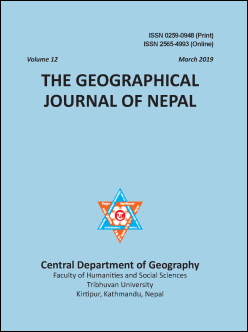Scale and spatial representation: Restructuring of administrative boundary and GIS mapping in Bajhang district, Nepal
DOI:
https://doi.org/10.3126/gjn.v12i1.23413Keywords:
modifiable areal unit problem, boundary restructuring, data classification, spatial patternAbstract
Census and other socio-economic survey data collected at household and settlement level are aggregated and results are presented for specific administrative units. The wide and increasing availability of census and socio-economic data, tools like GIS with an ease to use and advances in methodology has allowed increasing and refined GIS mapping of census variables. However, it is less emphasized that the result of analysis and presentation is always dependent on the unit of analysis. Data aggregation, choice of data classification method and spatial scale all have effect on mapping result. When administrative boundaries are restructured, it necessitates the aggregation of census data of one administrative level to another. In this context, the current paper explores the scale and zoning effect (changing boundary, changing number of units and data aggregation) on mapping census data. It explores the effect of four data classification methods at two spatial scales. Secondary data sources like local administrative boundary of Bajhang district and economically active population in agriculture is selected as representative census variable for mapping. GIS tool is applied for data mapping and analysis. The study found the higher calculated correlation value (0.88) for the restructured spatial units. The distribution of number of spatial units varied significantly between four data classification methods while plotted against the old boundary but there was not much variation in case of newly restructured boundary. The study found that zoning particularly, from smaller to larger units has blurred the spatial pattern visualization leading to a loss of the preferential information. The study concludes that the restructuring of administrative boundaries into larger unit has simplified the detail for spatial representation and has introduced additional generalization. For policy level analysis, use of data available at one level of the spatial unit when aggregated to higher level should be analyzed carefully using different data classification methods and visualization tools because scaled spatial representation matters in planning and policy aspect. It is meaningful to analyze data at different spatial scale to visualize and identify spatial variation.
Downloads
Downloads
Published
How to Cite
Issue
Section
License
© Authors




